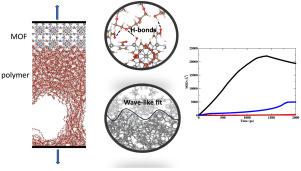Mechanistic insights into mechanical behavior of MOF-polymer membranes
IF 9.8
1区 材料科学
Q1 MATERIALS SCIENCE, COMPOSITES
引用次数: 0
Abstract
Efforts to optimize the performance of MOF-polymer mixed matrix membranes (MMMs) are often hindered by a lack of comprehensive understanding of interfacial interaction mechanisms. This study investigates the interfacial structure, dynamics, and mechanical properties of MMMs using molecular dynamics (MD) simulations. Models were developed by incorporating polyethylene glycol (PEG), polyvinylidene fluoride (PVDF), poly(methyl methacrylate) (PMMA), and polystyrene (PS) into optimized slabs of UiO-66, ZIF-8, and ZIF-90. While PEG and PVDF are known for their high compatibility with MOFs due to strong surface coverage, the rigid PS typically exhibits poor surface coverage. However, our findings reveal an intriguing exception: PS enhances the mechanical stability of ZIF-8 membranes through geometry interlocking at the interface, driven by interfacial dynamics. This behavior contrasts with PVDF, where mechanical stability is not significantly improved. These results emphasize that beyond surface coverage, the geometrical fit and interfacial dynamics are critical factors influencing membranes performance. We further evaluated the impact of polymer content by doubling the polymer layer thickness, which maintained stable Young’s modulus and tensile strength while enhancing failure strain. By highlighting the interplay between surface interactions and interfacial dynamics, this work provides valuable insights for optimizing the design and durability of MMMs for advanced applications.

mof聚合物膜力学行为的力学见解
由于缺乏对界面相互作用机制的全面理解,优化mof -聚合物混合基质膜(MMMs)性能的努力经常受到阻碍。本研究利用分子动力学(MD)模拟研究了MMMs的界面结构、动力学和力学性能。将聚乙二醇(PEG)、聚偏氟乙烯(PVDF)、聚甲基丙烯酸甲酯(PMMA)和聚苯乙烯(PS)加入优化的UiO-66、ZIF-8和ZIF-90板材中,建立模型。虽然PEG和PVDF因其强大的表面覆盖度而与mof具有高兼容性,但刚性PS通常表现出较差的表面覆盖度。然而,我们的发现揭示了一个有趣的例外:PS通过界面上的几何联锁,在界面动力学的驱动下,增强了ZIF-8膜的机械稳定性。这种行为与PVDF形成对比,PVDF的机械稳定性没有显著改善。这些结果强调,除了表面覆盖,几何配合和界面动力学是影响膜性能的关键因素。我们进一步评估了聚合物含量的影响,将聚合物层厚度增加一倍,在增加破坏应变的同时保持稳定的杨氏模量和抗拉强度。通过强调表面相互作用和界面动力学之间的相互作用,这项工作为优化先进应用中mm的设计和耐用性提供了有价值的见解。
本文章由计算机程序翻译,如有差异,请以英文原文为准。
求助全文
约1分钟内获得全文
求助全文
来源期刊

Composites Science and Technology
工程技术-材料科学:复合
CiteScore
16.20
自引率
9.90%
发文量
611
审稿时长
33 days
期刊介绍:
Composites Science and Technology publishes refereed original articles on the fundamental and applied science of engineering composites. The focus of this journal is on polymeric matrix composites with reinforcements/fillers ranging from nano- to macro-scale. CSTE encourages manuscripts reporting unique, innovative contributions to the physics, chemistry, materials science and applied mechanics aspects of advanced composites.
Besides traditional fiber reinforced composites, novel composites with significant potential for engineering applications are encouraged.
 求助内容:
求助内容: 应助结果提醒方式:
应助结果提醒方式:


